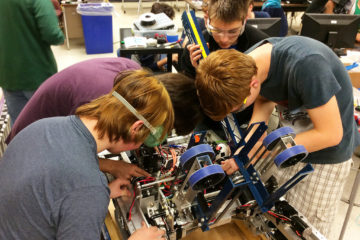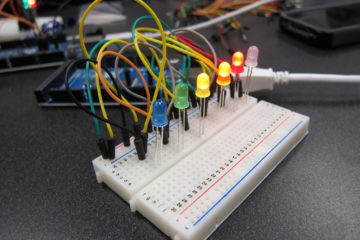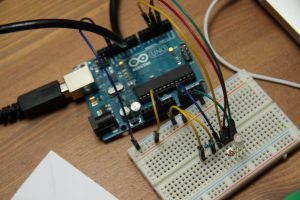Have you been handed the task to launch a new robotics program, improve an existing robotics class, or incorporate robotics & STEM in your classroom?
Are you a teacher or educator plagued by the mysteries of robotics & how to teach it?
When I work with schools and teachers, I’m often confronted by confusion: confusion from the teacher on how to teach robotics, and confusion by the administration as to which kits to buy, how much money it truly costs to run a robotics program, and the general lack of understanding. It’s no surprise that people are confused; robotics is a complex subject that includes a mixture of software, hardware, and integration in order to get right.
How to Start a Successful Robotics Program
This article (and accompanying eBook) was created to help solve the confusion and mystery behind developing a robotics program. I’ve included and outlined some of the key takeaways that will hopefully prevent you from making some common mistakes before your program is in place.
10 Steps to Start a Robotics Program (PDF)
Without a plan, there is no direction. Creating your robotics program is no exception! In this article, we will explore the first 5 steps to help get your robotics program up and running successfully!
Step 1 – Determine Your Audience
Step 2 – Choose Your Goal
Step 3 – Set Your Budget
Step 4 – Brainstorm Activities
Step 5 – Train Your Staff
BONUS CONTENT
Step 6 – Order Supplies
Step 7 – Focus on Programming
Step 8 – Use Freeware
Step 9 – Launch Your Program
Step 10 – Make Improvements

For an offline copy of this article, and an explanation of the last 5 steps, download a copy of my free eBook! I’ve included a printable checklist for you to track your progress!
Step 1 – Determine Your Audience
I realize that this step may seem obvious, but it’s often overlooked when robotics programs are rushed into existence.

Take time to determine answers to the following questions:
- Who are you teaching?
- What grade?
- Ages?
- Gender?
- Background?
- Likes/Dislikes?
Once you’ve mapped out the characteristics of your audience, you must think about others who would benefit most from taking your robotics class. Who can you involve in robotics that may not otherwise enroll in your class? What would appeal to them?
At this stage, you should have a solid understanding of who will be attending your class, it’s time to consider what you’re going to teach in “robotics.”
Step 2 – Choose Your Goal
What is “robotics,” and how do we teach it?
Robotics is a combination of Mechanics, Electronics, and Programming. Pick any combination of the three topics, integrate them strategically, and you’ll have the foundation for a great robotics class!
Mechanics
Building, Gears, Pulleys, Physics, Motors, Torque
Electronics
Circuits, Schematics, Breadboarding, Components, Sensors, Arduino
Programming
Flowcharting, Blockly, Scratch, C, C++, Python
In most cases, schools are very strong in teaching Mechanics but lack a curriculum that includes electronics and programming. If you want your school to stand out in STEM, then you must put time and effort into developing classes that include electronics and programming.
Step 3 – Set Your Budget
If you’re not aware, robotics programs require funding. You’ll need money for kits, supplies, and professional training. I’ve written a full article describing robotics budgets, but here’s a quick overview of how you can arrange your robotics budget.

I recommend setting aside a percentage of your budget (10-20%), called “Fluff”, to use for unexpected expenses such as replacement parts, improvements to your program, STEM activities
If your school doesn’t provide a separate budget for faculty training, plan to set aside $750-$1500 per teacher for development and training. Otherwise, you can exclude this item from the list. The nice thing about this template is that you can download a copy, fill it out, and present it as part of your proposal to the administration. Pretty nice, huh?! Get a copy of the robotics budget template, here.
Step 4 – Brainstorm Activities
You know the topics you want to teach, now it’s time to determine how you’re going to teach them. I’ve compiled a few ideas for each of the three areas of robotics for you to use during your planning. These are just ideas, so use them as a starting point, and not as the be-all-end-all!
Programming
Create a program to complete a morning routine.
Have students outline the steps that need to happen from start to finish (in order) so that this program works properly. If you have computers, translate this program into C, C++, or Python language and use the Serial Monitor to print out each step.
Here’s a great programming book to help you get started!
Electronics
Build a circuit that controls a breadboard and an LED. Have students list the components required, create a schematic, build the circuit, and determine alternative solutions to control brightness. If you have access to a microcontroller such as an Arduino, use code to control the LED’s behavior.
Mechanics
Design and build race cars to explain how gear trains and torque work. You can easily tie this lesson into physics, gear ratios, and the equation for torque. Test out your students’ solutions using a designated race track. For added flair, add sensors to the playing field to automatically trigger the start & end time, calculate speed, and measure acceleration.
You could also learn about levers and linkages using a mechanics kit similar to this one.
Step 5 – Train Your Staff
95% of schools do not train their robotics teachers. Is your school part of that statistic?
If you want your robotics program to be fun, interactive, and sustainable, you must invest in the teachers who are teaching it. Often times teachers are handed a box of robot kits and told to teach robotics tomorrow.
Do we hand 16-year-olds keys to a car and tell them to go ahead and drive?
Absolutely not.
Teachers are the HEART of the CLASS
Your robotics program is only as good as the teachers teaching it. Make sure they’re prepared through professional training and development programs specific to robotics, electronics, and programming
For more details on how Learn Robotics can help, visit the Educator’s Page!
Since robotics has a lot of moving pieces, teachers need to be able to build, wire, program, troubleshoot, and be innovative with their robotics classes. It shouldn’t just be downloading lesson plans and letting students follow along at their leisure.
If you want a good robotics program, you have to put effort into it. Dust off that box of robot kits take a few classes, and you’ll be well on your way to seeing test scores rise, greater student engagement, and the satisfaction of teaching the coolest subject on Earth!
But wait, there are 5 more Steps!
Thanks for reading this far! If you liked this article, you’re going to love the eBook!
10 Steps to Start a Robotics Program (PDF)
I’ve been wanting to compile a guide outlining the First 10 Steps for Starting a Successful Robotics Program, and it’s finally arrived! In this guide, I’ve provided an in-depth tutorial for each of the 10 steps, copies of the budgeting spreadsheet, and a printable checklist that you can use to keep track of your progress.

If you liked this article, be sure to share it, and let me know your thoughts in the comments below!
Did you try these steps out? What’s been your experience with robotics?





